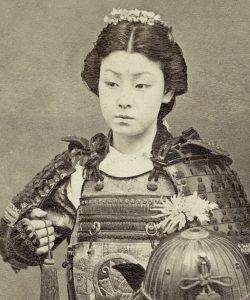Christobel Hastings in Broadly:
 It was the autumn of 1868, and for the samurai warriors of the Aizu clan in northern Japan, battle was on the horizon. Earlier in the year, the Satsuma samurai had staged a coup, overthrowing the Shogunate government and handing power to a new emperor, 15-year-old Mutsuhito, who was wasting no time in replacing the feudal ways of the ruling Tokugawa with a radically modern state. After a long summer of fighting, imperial forces reached the gates of Wakamatsu castle in October to quash the resistance, besieging the stronghold with 30,000 troops. Beyond its walls, 3,000 defiant warriors readied themselves for the final stand.
It was the autumn of 1868, and for the samurai warriors of the Aizu clan in northern Japan, battle was on the horizon. Earlier in the year, the Satsuma samurai had staged a coup, overthrowing the Shogunate government and handing power to a new emperor, 15-year-old Mutsuhito, who was wasting no time in replacing the feudal ways of the ruling Tokugawa with a radically modern state. After a long summer of fighting, imperial forces reached the gates of Wakamatsu castle in October to quash the resistance, besieging the stronghold with 30,000 troops. Beyond its walls, 3,000 defiant warriors readied themselves for the final stand.
As the Aizu fought valiantly from the towers and trenches, most women remained behind the scenes, ploughing their energies into cooking, bandaging, and extinguishing cannonballs that pounded the castle day and night. But for Nakano Takeko, an onna-bugeisha woman warrior, front line defense was the only course of action. Faced with the mighty gun-power of the imperial army, Takeko led an unofficial unit of 20-30 women in a counter-attack against the enemy, felling at least five opponents with her naginata blade before taking a fatal bullet to the chest. With her dying breaths, Takeko asked her sister to behead her, so that her body wouldn’t be taken as a trophy. She was buried under a tree in the courtyard of the Aizu Bangmachi temple, where a monument now stands in her honor.
More here.
